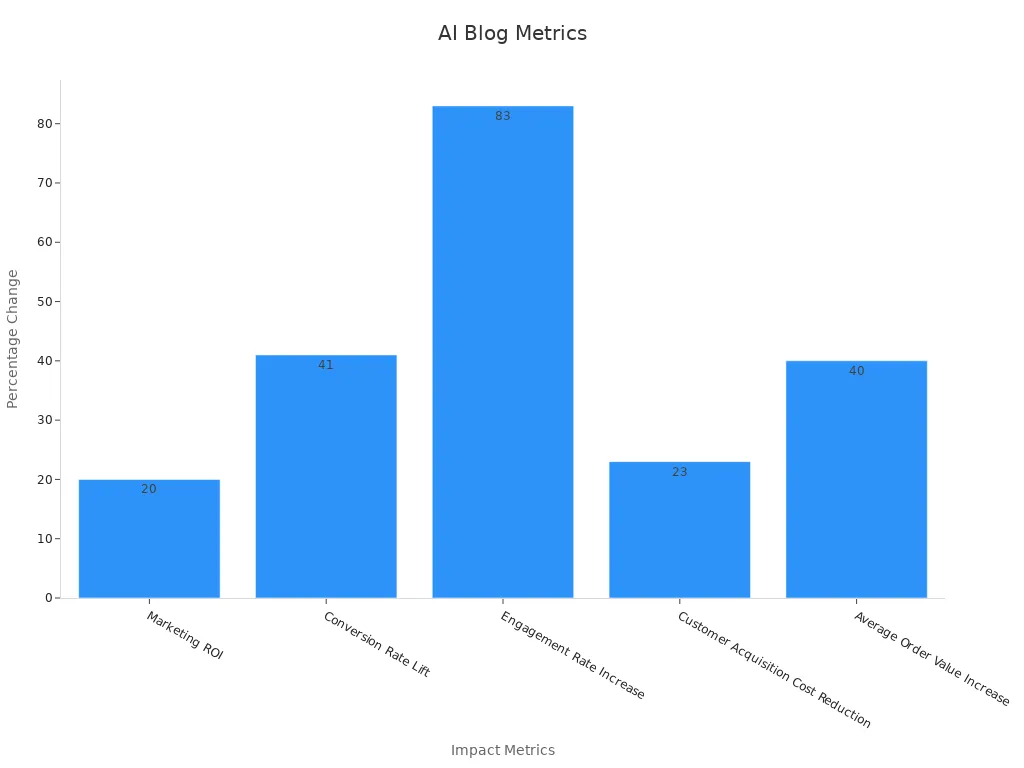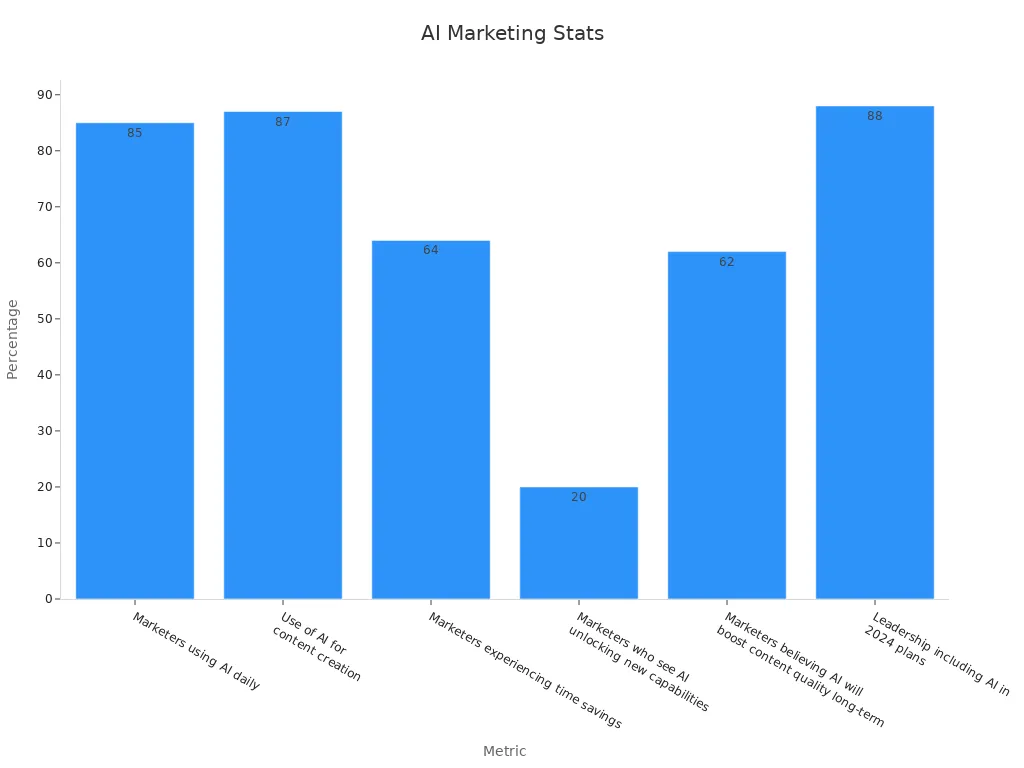How AI Turns Voice-of-Customer Data into Blog Ideas

AI turns data from customer voices into blog ideas that truly resonate with people. When you use AI, you move beyond just numbers and start focusing on what your audience genuinely likes. Companies like Netflix and Airbnb have increased sales by using AI to tailor content and images to each individual. Marketers now analyze clicks, time spent on a page, and social media shares to understand what works best.
Many businesses see great results: 44.4% of marketers use AI, which turns data into actionable insights, helping them work faster and connect more effectively with customers.
Key Takeaways
AI takes customer feedback from surveys, reviews, and social media. It turns this feedback into blog ideas that readers like. - AI tools help collect and study data faster. They give correct insights and do not have human bias. - AI finds key themes and trends early. This helps you make content that stays important and connects with people. - AI can make blog ideas personal. This makes readers feel heard and can boost engagement and sales. - AI watches your blog all the time. It helps you keep your blog new and fix problems fast. This builds trust and gets better results.
Collecting Data

Voice-of-Customer Sources
You can get voice-of-customer data from many places. Each place shows what your customers think and feel in a different way. Here are some common ways to collect this data:
Surveys like NPS, CSAT, CES, and U&A help you learn about loyalty, satisfaction, and attitudes. These surveys give you numbers and also let people write their thoughts.
Online reviews and social media show honest opinions. People share what they like and dislike. Social listening tools help you see these comments as they happen.
Sentiment analysis on social media helps you find out how customers feel. You can spot feelings and needs that surveys might miss.
When you use surveys, reviews, and social media together, you get a better picture. This helps you see what topics matter most to your audience.
Companies like Wendy’s, Home Depot, and Amazon use this data to make content that connects with customers.
You can also use chat messages, interviews, and focus groups. These ways give you personal stories and deeper ideas. Reviews, like star ratings and comments, show what people care about most and act as proof for others.
Tip: Using many ways to collect data helps you get better answers. You do not have to use just one way, and you can avoid making people tired of surveys.
AI Tools for Collection
AI tools make it much easier to collect and study voice-of-customer data. You can use platforms that look at thousands of reviews, social posts, and survey answers in just minutes. For example, EnerSys uses an AI system to check utility bills from 180 sites around the world. The platform finds important details, spots strange data, and makes things more accurate. EnerSys also uses ChatGPT Enterprise to look at big sets of data and answer customer questions faster. This way, they spend about half as much time on these jobs. With AI, you can trust your data and spend more time making content that matters.
AI Turns Data into Insights

When you use AI Turns Data, you find the real value in customer feedback. This helps you go from simple comments and reviews to clear ideas you can use. AI can take things like call recordings, support tickets, and social media posts and turn them into easy-to-read summaries. You get scores that show how people feel, maps of the customer journey, and even guesses about what customers might want next. This makes your work easier and helps your team make better choices faster.
Theme Extraction
AI Turns Data into insights by finding patterns in what customers say. You do not need to read every comment yourself. AI looks at all the feedback and puts similar ideas together. This helps you see what is most important to your audience.
AI cuts down on human bias by checking all the data, not just a few pieces.
Text mining and sentiment analysis show what people really think and feel.
You get a fuller picture of what customers need and what problems they have.
For example, Vodafone New Zealand used AI to study thousands of NPS comments. The system quickly found the main problems customers had. Vodafone made changes based on these results. After nine months, their NPS score went up, and they got a good return on their investment.
Note: AI-driven theme extraction gives you accurate insights based on data. You can trust the results because the process checks each theme with the original feedback.
You can also use these insights to make customer personas. AI groups customers by what they need, how they act, and what they like. This helps you make content that fits each group.
Benefit of Theme Extraction | How It Helps You |
|---|---|
Less bias | More fair decisions |
Faster analysis | Quicker answers to feedback |
Deeper insights | Better understanding of needs |
Trend Detection
AI Turns Data into a strong tool for finding new trends. You can spot changes in what customers think and want before others do. AI watches talks across many places and finds changes in words, feelings, and topics.
A restaurant chain used AI to see more people wanted plant-based menu items. They added new dishes and saw great results.
A retail company learned that customers in some places thought staff were not friendly. They used this to train workers and make service better.
A software company found out users liked a new interface, so they worked to improve it even more.
AI-powered tools like Qualtrics XM, Brandwatch, and Sprout Social help you watch these trends as they happen. In 2024, 76% of companies using AI for trend watching found big market changes at least three months before others. This early warning lets you act fast and stay ahead.
Tip: Real-time trend detection means you can fix problems or try new ideas quickly. You do not have to wait for slow reports or surveys.
AI Turns Data into a helpful tool by letting you guess what customers will want next. You can change your content, products, and marketing to match these trends. This keeps your business important and your customers happy.
Generating Blog Ideas
Content Ideation
AI Turns Data is a strong tool for making blog ideas that fit what people want. You do not need to guess which topics will be popular. AI looks at feedback, reviews, and what people do online. It finds patterns and gives you topics that matter to people right now.
AI-powered tools help you plan your content faster. These tools check what your customers search, read, and share. They show you where your content is missing things and give you new ideas. For example:
HubSpot’s content assistant AI gives you outlines based on real data. You get a plan before you write.
Portent’s Content Idea Generator makes SEO-friendly titles and subheaders from keywords your audience uses.
BuzzSumo and AnswerThePublic look at search trends, social media, and other blogs. They suggest trending and special topics, so you always have new ideas.
StoryChief’s AI agent checks your brand and what your audience likes. It finds trending topics and content gaps, like long posts about sustainable fashion or LinkedIn posts for certain groups.
Tip: Use AI to sort your ideas before you start writing. This saves time and helps you focus on what your readers care about most.
AI Turns Data helps you make blog ideas that connect with your audience. You can see what works by checking important numbers. The table below shows how AI blog ideas can help you:
Key Metric | Evidence of AI Effectiveness |
|---|---|
Engagement Rates | AI-made titles get more likes, shares, and comments, showing better audience interaction. |
Conversion Rates | AI-picked titles help get more sign-ups and sales, showing more blog visitors take action. |
Click-Through Rate (CTR) | AI headlines beat human ones in 46% of tests, with up to 59% higher CTR, showing AI can bring in more readers. |
Bounce Rate | AI helps lower bounce rates by picking titles that keep visitors on your page longer. |
You can see even more good results when you look at the whole picture. AI content strategies help you get more from your marketing, boost engagement, and help your blog show up higher in search results. Here is a chart that shows how AI helps blog performance:

Personalization
Personalization means you make blog ideas that talk to different groups of readers. AI helps by looking at customer data and learning what each group likes. You can use this to write blog posts that feel special and important to each group.
Modern AI tools let you study browsing history, past buys, and how long someone stays on a page. You can then suggest other articles or make new posts that match each reader’s interests. Some AI systems show different blog topics to different users based on what they do. This makes your content feel like it was made just for them.
Research shows AI-powered personalization works well. The 2025 State of ABM report shows top marketing teams use AI to make blog ideas that fit each person. These teams look at lots of customer data and use AI to send messages that match what each person wants. People now want blogs and articles to feel like a real talk, not just a general message.
You can check if personalized blog ideas work by looking at clear numbers. The table below shows how AI personalization helps:
Metric / Finding | Impact on Effectiveness of AI-Generated Blog Ideas |
|---|---|
Marketing ROI increase | AI content strategies give about 20% higher marketing ROI, showing better returns from AI blog ideas. |
Conversion Rate Lift | Conversion rates go up by 41% on average with AI content, showing more leads and sales from AI blog ideas. |
Engagement Rate Increase | Engagement rates rise by up to 83%, with more time on page and social shares, showing stronger audience interaction with AI content. |
SEO Performance | AI helps get 43% faster first-page rankings and 78% better chances of ranking for many keywords, bringing more visitors from search. |
Customer Acquisition Cost Reduction | AI lowers costs by 23%, showing it is cheaper to turn blog visitors into customers. |
Average Order Value Increase | AI-powered personalization leads to a 40% higher average order value, showing more money from AI content strategies. |
Note: When you use AI for personalization, your readers feel understood. This builds trust and makes them want to come back.
You can use AI Turns Data to keep your blog ideas new and important. By focusing on what your audience wants, you help your content stand out online.
Optimizing and Scaling
SEO Alignment
AI can help make your blog easier to find online. When you use voice-of-customer data, you learn what people want to read about. This helps you choose the best keywords and topics. You can also answer real questions from your readers, which makes your blog more useful.
Here are some ways AI helps with SEO:
Add structured data markup to FAQ pages. This helps your blog show up in special search results.
Use long-tail keywords that come from what your customers say. These keywords often bring in people who are ready to buy or sign up.
Link to other blog posts on your site. This keeps readers on your website longer and makes your blog stronger.
Use tools like Google Analytics and Ranktracker to watch your traffic. These tools show if your changes are helping.
Check how long people stay on your page and how often they leave. If your blog matches what people want, they will stay longer and leave less.
When you use these tips, you get real results:
More people visit your blog from search engines.
Readers spend more time reading your posts.
You get more leads and sales because your blog helps visitors find what they need.
Tip: Keep collecting voice-of-customer data from surveys, reviews, and social media. This helps you know what your readers want right now.
Continuous Monitoring
Continuous monitoring helps you keep your blog ideas new and correct. AI tools check feedback and trends all the time. This means you can see changes in what people care about and update your blog fast.
Here is a table showing how companies benefit from ongoing monitoring:
Evidence Type | Description |
|---|---|
Accuracy Improvement | Hybrid sentiment analysis systems achieve up to 91% accuracy, outperforming single-method systems by 17%. |
Negative Sentiment Reduction | Companies using real-time sentiment dashboards reduced negative user sentiment by 34% within six months. |
Domain-Specific Models | NLP models trained on specific topics improve sentiment accuracy by 37%. |
Case Studies | Microsoft increased user satisfaction by 24%; Adobe saw a 40% rise in positive sentiment after applying AI monitoring. |
ROI Impact | Sentiment analysis yields an average ROI of 287% over three years, with faster issue detection and lower support costs. |
You can also track important numbers like accuracy, precision, recall, and F1 score. These numbers help you see if your AI tools are working well. When you watch these numbers, you can fix problems early and keep your blog topics important.
Continuous monitoring helps you spot new trends, fix problems, and keep your blog helpful for your readers. This helps you stay ahead and makes your readers trust you.
You have learned how AI can help you use voice-of-customer data to make blog ideas that people care about. When you collect feedback, spot trends, and make content special for each group, your posts connect better with readers. Most marketers use AI every day now. About 87% use it to make content, and 64% say it saves them time. The table below shows how AI helps marketing work better:
Metric / Statistic | Value / Percentage |
|---|---|
Marketers using AI daily | |
Use of AI for content creation | 87% |
Marketers experiencing time savings | 64% |
Marketers who see AI unlocking new capabilities | 20% |
Marketers believing AI will boost content quality long-term | 62% |
Leadership including AI in 2024 plans | 88% |
Leadership advocating increased AI use | ~60% |

AI-powered tools help you keep your blog new and interesting. Try these tools to help your business grow and give your customers what they want.
FAQ
How does AI know which blog topics your audience wants?
AI looks at what your customers say in surveys, reviews, and social media. It finds patterns and popular topics. You get blog ideas based on real feedback, not just guesses.
Can you use AI tools if you have a small business?
Yes, you can. Many AI tools work for small businesses. You do not need a big budget. Start with free or low-cost platforms to collect and analyze customer feedback.
Will AI-generated blog ideas sound robotic?
No, they will not. You control the final content. AI gives you ideas and outlines. You add your voice and style. This keeps your blog posts sounding natural and personal.
How often should you update your blog ideas with AI?
Check your voice-of-customer data every month. Update your blog topics when you see new trends or feedback. This helps your content stay fresh and relevant.
Tip: Regular updates keep your blog interesting and help you connect with your readers.
See Also
Transforming Blogging With AI Tools That Redefine Success
Proven Methods To Grow And Engage Your Blog Audience
Customizing Blog Posts To Suit Startup Audience Demands

